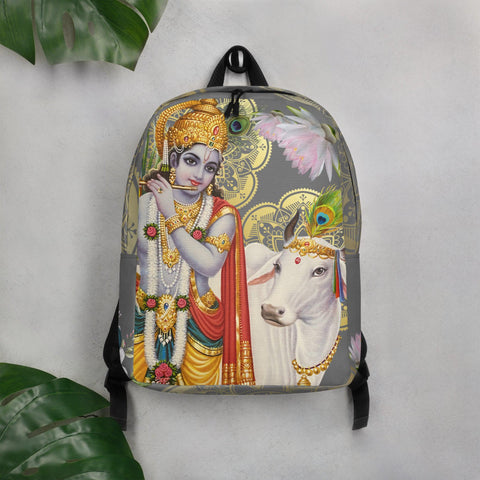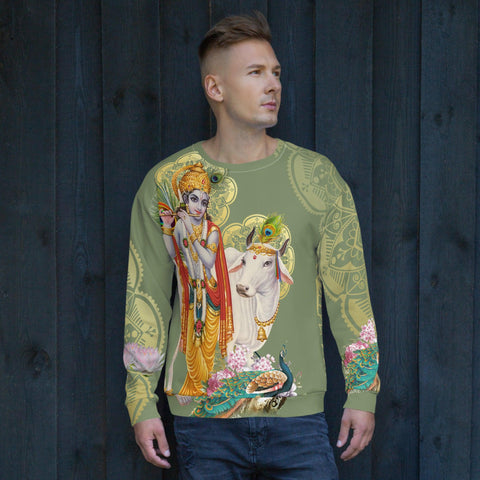Radha: The Name, Meaning, and Devotion of the Goddess of Love
Posted by Massimiliano Geraci

In searching for understanding and connection, many turn to the stories and teachings of ancient cultures. Among these, the tale of Radha, the Goddess of Love in Hinduism, stands out as a beacon of divine love and devotion.
This goddess's name carries profound meaning, embodying compassion, devotion, and an eternal bond with Lord Krishna.
Radha is not just a figure of myth; she is a symbol of pure love and spiritual enlightenment. Our exploration will reveal how her story interweaves through classical literature to modern interpretations, highlighting temples dedicated to her, worshiped here alongside Krishna.
This journey into Radha's world of significance promises insight into the essence of divine love.
Discover the depth of Radha’s story.
What is the meaning of Radha?
The name Radha carries profound significance in Hindu tradition, symbolizing the epitome of devotion and love for Krishna. She embodies the divine feminine energy, Shakti, seamlessly merging with Vaishnavism's core teachings on Bhakti or devotion.
Her story transcends mere mythology, representing an ideal of pure love and spiritual fulfillment. As the eternal consort of Krishna, Radha's relationship with him illustrates the ultimate union between devotee and deity, where earthly affection transforms into a celestial bond.
Radha's essence is captured through sacred texts like the Bhagavata Purana and resonates within major devotional movements across India. Emphasized by saints such as Chaitanya Mahaprabhu and revered in temples dedicated to her, worshiped alongside Krishna, she stands as an immortal symbol in Hindu spirituality.
Her influence stretches beyond theology into cultural contexts—inspiring countless works of art, literature such as Jayadeva’s Gita Govinda, dance forms like Manipuri Raas Leela, and music that explore her divine love story with Krishna.
Radha personifies unconditional devotion to God.

Understanding the name Radha
Radha, often revered as the Goddess of Love and Devotion in Hinduism, holds a pivotal place alongside Krishna. Her name symbolizes both devotion and the deepest form of love. Exploring the meaning of Radha’s etymology leads us to understand her transcendent role in Hindu scriptures such as the Puranas and the Bhagavad Gita, where she is depicted not just as an ordinary gopi but as Krishna's highest consort.
This divine female relationship sets an exemplary paradigm of unconditional female love.
Her titles, including Radharani and Radha Rani, further emphasize her esteemed position within the spiritual fabric of Hinduism. These names echo through temple songs at places like Jagannath Temple and are celebrated in festivals aligned with devotion (bhakti) movement principles across regions like Vrindavan.
Moving beyond mere nomenclature, these appellations underscore Radha’s embodiment of grace and compassion that magnetically draws devotees to her eternal story with Krishna. Next, we examine the Significance of Radha in Hinduism to unwrap more layers around this celestial figure.
Significance of Radha in Hinduism
In Hinduism, the figure of Radha embodies unparalleled devotion and love, setting the supreme example of spiritual dedication to God Krishna. Her stories with Krishna in texts like the Bhagavata Purana highlight her role as not just a mere consort but as an eternal partner, symbolizing the soul's intense longing and unconditional attachment to the divine.
This narrative captures hearts across cultures, making her an indispensable part of worship in traditions such as Gaudiya Vaishnavism and Vallabha Sampradaya. Radha’s significance extends beyond mythology into practical spirituality, where she is revered as a deity who guides devotees on their journey to enlightenment and pure bhakti.
Her influence permeates various aspects of Indian culture, from classical literature to temple songs in Jagannath Temple, enriching religious texts and artistic expressions alike. Temples dedicated to Radha Krishna, such as Shri Radha Vallabh Temple and Shri Radha Govind Dev Ji Temple, serve as centers for her veneration—attesting to her pivotal presence within devotional practices.
These sanctuaries offer spaces for followers to engage with the divine pastimes (leelas) of Radha alongside Krishna through rituals that emphasize unity with the godhead during daily worship (puja) sessions.
Artists depict her ethereal beauty and grace in myriad forms across centuries; from ancient Sanskrit epics to modern reinterpretations in poetry and dance, detailed in the Sanskrit language and referenced in resources like the Sanskrit English Dictionary and Wisdom Library, recounting their legendary romance and imbuing society with values rooted in compassion and selfless love.
Symbolism behind the name Radha
Moving from the significance and origin of Radha by birth name in Hinduism, we turn our attention to the layers of meaning embedded within her name. The name Radha is rich with symbolic connotations, serving not just as baby name or an identifier but also as a profound expression of spiritual and devotional nuances.
Radhas symbolize devotion and depict the pinnacle of unconditional love and compassion for Krishna.
The essence behind the origin of the name transcends its literal interpretation; it encapsulates Radha's role as the eternal consort and wedded wife of Krishna, highlighting an inseparable union that reflects the highest form of devotion.
This divine relationship stands at the core of worship in traditions like Gaudiya Vaishnavism and forms a cornerstone in temples dedicated to their worship such as Radha Vallabh Sampradaya.
Here, "Radha" represents more than a mere character—it embodies selfless love and dedication that devotees strive to emulate in their own spiritual journeys toward enlightenment.
Radha manifests pure devotion, embodying eternal love for Krishna beyond mere words.

Who is the Goddess Radha?
Goddess Radha stands as the embodiment of divine love and compassion, celebrated across Hindu scriptures for her unwavering devotion to Lord Krishna. Offering a profound example of true love, her story with Krishna transcends the boundaries of mere romance, symbolizing the soul's intense longing and ultimate union with the Divine.
In traditions like Gaudiya Vaishnavism, she is revered not just as Krishna's beloved but as his equal, showcasing a partnership that exemplifies perfect spiritual harmony and balance.
Her depiction in sacred texts such as padma purāṇa and Brahma Vaivarta Purana elucidates Radha's role beyond an ordinary consort; she is often portrayed as an inseparable part of Krishna, emphasizing their oneness.
Devotees worship Radha along with Krishna in temples dedicated to their divine love story, like the famous Radha Raman Temple and Govind Dev Ji Temple. This veneration speaks volumes about her significance in bhakti movement spirituality where her compassion, virtue, and unconditional love towards Krishna guide devotees towards a path of selfless devotion and spiritual enlightenment.
Through kirtan (spiritual song) rituals celebrating pastimes of Radha Krishna they aim to emulate this celestial bond in their daily lives.
Radha: The Goddess of Love
Radha embodies the essence of divine love and devotion, capturing hearts as the goddess who personifies compassion and tenderness. Her relationship with Krishna represents an eternal love story that transcends the boundaries of the earthly domain, holding a central place in Hindu spirituality.
As Krishna's eternal consort, Radha is inseparable from him, illustrating a profound union celebrated across numerous devotional service and traditions.
Worship of Radha Krishna flourishes in temples, as well as in art, literature, and music, reflecting their status as a divine couple adored by millions. The devotion to this duo symbolizes the pursuit of spiritual enlightenment through love and dedication.
Devotees gather at places like Radha Kund and participate in rituals that honor their sacred bond, finding inspiration in tales that describe Radha's unwavering affection for Krishna.
Through these acts of worship, followers seek to emulate her qualities of unconditional love and fidelity.
Radha and Krishna: A Divine love story
Transitioning from the celestial embodiment of love that Radha represents, we move to a narrative that has been etched in the hearts and minds of millions for centuries: the divine love story of Radha and Krishna.
This tale is not just a cornerstone of devotion within Hinduism but also a significant cultural touchstone across various artistic and spiritual landscapes. The union of Radiah and Krishn symbolizes an eternal bond beyond mere mortals, captivating followers with its depth of passion and spiritual dedication.
This story, deeply rooted in ancient texts like the Bhagavata Purana and celebrated in rituals at temples such as Radha Madhav Dham in Austin, transcends time. It's revered for its portrayal of unyielding love and for illustrating the complexity, meaning and beauty found within devotional relationships.
Depictions of their sacred union are prevalent throughout numerous forms of art, literature, and music - each incarnation aims to capture the essence of its divine consort and inseparable nature.
Through these expressions, devotees find guidance on their own spiritual journeys toward enlightenment and compassion toward all beings; making the relationship between him and his beloved one of the most profound narratives ever told in human history.

The Worship of Radha Krishna
Devotees celebrate the union of Radha and Krishna with deep reverence, viewing their relationship as the pinnacle of divine love. This worship encompasses a range of rituals, songs, dances, and festivals that resonate across various cultures within Hinduism.
The Raslila performance, depicting the celestial dance between Radha and Krishna among the Gopis, stands out as a profound expression of devotion. Temples dedicated to Radha Krishna dot landscapes in regions like Bengal and Assam, where the Vaishnava Sahajiya tradition flourished.
Here, prayers rise in harmony with ancient temple songs still echoing through halls dedicated to their divine love.
Followers often seek guidance from texts like the Bhagavata Purana and practices outlined by spiritual figures such as Chaitanya Mahaprabhu and Swami Haridas. These sacred writings and teachings help devotees cultivate an internal connection with Radha Krishna, transcending mundane existence through meditation on their eternal companionship.
Across India’s vast expanses—from Manipuri Vaishnavism to Nimbarka Sampradaya—such worship sustains traditional expressions and adapts them into contemporary forms of adoration for these beloved deities.
What are the different names and titles of Radha?
Radha, often celebrated as the Goddess of Love in Hindu texts, is known by numerous names and titles that reflect her multifaceted nature. Among these, "Shri Radhika" stands prominent, deeply rooted in Sanskrit literature and revered across the world by various schools of thought within Hinduism.
This title signifies her as the esteemed companion of Krishna, embodying divine love and devotion to supreme lord. Similarly, "Radharani," another widely used name, accentuates her royal status among the gopis (cowherd women), highlighting her unparalleled love for lord Krishna.
Several regional variations further enrich our understanding of Radha's significance across cultures. In Bengal and Assam, where the tantric Vaishnava-Sahajiya tradition flourished, she is venerated not just as Krishna's consort but as a powerful symbol of spiritual enlightenment and cosmic harmony.
The Devi Bhagavata Purana mentions the name Radha, alongside other key figures like Narayana and Lakshmi, showcasing her integral role in Hindu mythology. Through these varied names—each echoing respect and adoration—followers express their deep connection to Radha’s divine essence.
Finding Radha is finding the path to unconditional devotion.
Transitioning from discussing the goddess's many names to exploring how artists have depicted this celestial figure offers a glimpse into how spirituality inspirits creativity.
Popular Titles of Goddess Radha
Goddess Radha, infallible supreme personality revered across various cultural landscapes, embodies the quintessence of love and devotion in Hinduism. Her names and titles reflect her multifaceted nature, weaving a tapestry of symbolic meanings that enrich the spiritual fabric of her devotees' lives.
1. Radhika: Often used interchangeably with Radha, this name highlights her role as the foremost devotee of Krishna. It suggests someone who is able to bring joy or achieve success through their profound love and dedication.
2. Kishori: Meaning young girl, this title portrays Radha in her eternal youthfulness, embodying purity and innocence. It emphasizes her status as the eternally youthful consort of Krishna, evergreen in her love and devotion.
3. Madhavi: This title associates Radha with springtime, symbolizing renewal and growth. As Madhavi, she personifies the rejuvenating energy that revives the love between herself and Krishna each time they meet.
4. Radharani: Adding a regal touch, 'Rani' translates to queen, making Radharani denote "Queen Radha". It acknowledges her supreme position among all of Vishnu's consorts, reflecting her unparalleled devotion and significance in Krishna's life.
5. Hari Priya: Literally translating to "beloved of Hari" (another name for Lord Vishnu), this title underlines Radha's cherished status as the most beloved of Lord Krishna.
6. Vrindavaneshwari: Meaning the queen of Vrindavan, this name situates Radha as the presiding deity over Vrindavan - the place where she shared countless divine pastimes with Krishna.
7. Gopi of Gopis: Recognizing her leadership among the gopis (cowherding girls) who are all devotees of Krishna. This title highlights her eminent status as first among equals in their collective adoration for Krishna.
8. Yamuna Jivana: Denoting "the life of the Yamuna", this reflects on how both Radha's presence and their divine pastimes along the banks rejuvenate and add vitality to river Yamuna itself.
9. Shyamaa: A name that mirrors one aspect orissa of Krishna's complexion - 'Shyam', meaning dark-complexioned - indicating their inseparable bond by reflecting each other even in names.
10. Radhavallabha Priya : Signifying "beloved of Lord Radhavallabha”, a special title that reinforces her deep connection with Lord Krishna who is also worshipped under this name at places like Vrindavan.
As these titles suggest, Goddess Radha transcends singular interpretations; through each epithet, she unveils diverse dimensions which are celebrated by followers worldwide. Moving forward into discussions about regional variations reveals even more aspects about how differently cultures perceive and honor this deity’s universal essence.
Names like Radha in Scriptures
The name Radha carries profound significance across various scriptures, embodying love, devotion, and divine connection. These texts, revered in Hindu tradition, present her as an emblem and avatar of unconditional love and infinite compassion towards Krishna.
1. Radharani - Often venerated as the supreme goddess in Gaudiya Vaishnavism, Radharani signifies the epitome of devotion (Bhakti) to Lord Krishna. The Brahma Samhita describes her as the heart and soul of Krishna, illustrating their inseparable bond.
2. Hara - Found within the ancient Vedas, "Hara" denotes the captivating power of Lord Shiva's consort but is also linked to Radha when decoded through etymological layers, showing her as a source of enchantment for Krishna.
3. Kishori - References in texts like the Naradiya Purana highlight "Kishori" as another name for young Radha, representing her eternal youthfulness and vigor that charms Krishna.
4. Madan-Mohan-Mohini - Mentioned in several Puranic texts, this title identifies Radha as the only one who can mesmerize Madan (the god of love), whom even Lord Krishna cannot resist.
5. Vrindavaneswari - Acknowledged in regional literature and songs from Bengal and Assam, this title crowns her as the queen of Vrindavan's forests where divine leelas (playful acts) between Radha and Krishna unfold.
6. Radhika - This affectionate variant found in Jayadeva's Gita Govinda highlights her impeccable virtues and unparalleled beauty that ensnares Krishna's heart.
7. Shyama - A term extracted from tantric traditions and echoed in Shaivism scriptures portrays Radha with a dark complexion symbolizing the all-absorbing nature of divine love.
Each designation attributed to Radha reveals different facets of her divinity and contributions to Hindu mythology’s rich tapestry, reinforcing her significance beyond a mere consort but as an omnipresent symbol of unwavering faith and spiritual bliss shared with Krishna.
Regional Variations of the name Radha
Radha, a name revered across various cultures and regions, carries with it a tapestry of meanings and spiritual significance. The regional variations of this name highlight the deep-rooted devotion to the goddess and her diverse representations within Hinduism.
1. In Bengal, Radha is often referred to as "Radharani" or "Radhika," emphasizing her status as the queen (rani) of Radha Krishna's heart. This variation underscores her central role in Bengali Vaishnavism, where she epitomizes divine love and compassion.
2. The Braj region presents Radha as "Shrimati Radharani," accentuating her supreme beauty and grace. This form echoes throughout the Krishna-centric traditions where the love saga of Radha and Krishna is celebrated.
3. Assam's Vaishnava Sahajiya tradition highlights Radha's esoteric aspects through names like "Kamalini" (one resembling a lotus) and "Vrindavaneswari" (queen of Vrindavan). Assam flourished with tantric practices, integrating Radha’s worship in their mystical rituals.
4. South India introduces Radha with unique appellations like "Rukmini," aligning her identity closely with Krishna’s consort acknowledged in texts like Mahabharata. Although differing in narratives, Rukmini embodies similar virtues of devotion found in tales of Radha.
5. In Maharashtra, she transforms into "Radhe Govinda", melding her identity with that of Lord Krishna's to signify their inseparable union in Marathi folk traditions centered around their divine love story.
6. These points explain how regional narratives and practices around the figure of Radha have evolved, underlining the complex tapestry of cultural interpretations that surround this iconic deity.
7. Each variation not only enriches our understanding of Radha but also illustrates the multifaceted nature of Hindu spirituality itself, reflecting local beliefs, artistic expressions, and devotional practices dedicated to celebrating the goddess’s eternal bond with Krishna.
How is the Goddess Radha depicted in art and literature?
In classical literature, Radha emerges as the central figure of divine love and compassion. Literature by poets like Jayadeva in his epic poem constantly highlights her deep devotion to Krishna, depicting their relationship as the epitome of spiritual love.
These texts often illustrate Radha's intense longing for Krishna, which symbolizes the soul's yearning for connection with the divine. Through these portrayals, she is revered not just as a consort of Krishna but also an embodiment of supreme devotion.
Artists have captured Radha's essence through various forms across centuries, where she is often depicted alongside Krishna amid idyllic settings of Vrindavan—symbolizing eternal love and harmony material nature.
The artistic representations range from intricate paintings in manuscripts to elaborate sculptures in temples dedicated to Radha-Krishna. In each piece, her image conveys serenity and unconditional love, deeply inspiring devotees and art lovers alike.
This immortalization in art continues to fuel admiration for Radha among those who seek spirituality through the lens of Indic traditions.
Radhā madhab temple songs echo with tales of undying devotion.
Radha in Classical Literature
Classical literature paints Radha as a symbol of devotion and love, highlighting her role beyond the mere consort of Krishna. Texts such as Jayadeva's epic poem, the Gita Govinda, explore the profound relationship between Radha and Krishna, offering readers a glimpse into divine love embodied.
This piece stands out in Sanskrit literature for its intricate portrayal of their union, illustrating Radha's importance not just as a deity but as an epitome of unconditional love.
Her character, filled with compassion and deep affection for Krishna, resonates throughout Hindu classical writings.
Notably, Acharyas like Jiva Goswami have dedicated significant work to exploring Radha’s spiritual significance. In these texts, she is often depicted inseparable from Krishna — regarded as his eternal companion who amplifies his divine attributes.
Such writings contribute extensively to Vaishnavism theology, positioning Radha centrally in devotional practice alongside Krishna. Through their narratives set in Bengal and Assam where Tantric Vaishnava-Sahajiya tradition flourished, classical literature underscores her pivotal role in bringing devotees closer to understanding complex theological concepts by personifying selfless devotion and spiritual purity.
Radha in Modern Interpretations
Bridging from Radha's portrayals in classical literature, her image and story transcendentally unfold into contemporary interpretations, reflecting an evolving cultural tapestry. Today's depictions of Radha also highlight her as an embodiment of divine love and compassion, yet they layer her narrative with modern sensibilities.
Filmmakers, authors, and artists reimagine Radha beyond the ancient texts, connecting her eternal romance with Krishna across diverse other languages and media platforms. These adaptations delve into nuances and details not just of their spiritual connection but also explore Radha’s individuality—a facet less emphasized in traditional scriptures.
The influence of Radha in popular culture extends to music and dance performances where the love between Krishna and Radha is celebrated through contemporary renditions that resonate with today's audience.
Festivals dedicated to Radhā-Kṛṣṇa continue to incorporate modern forms of worship and artistic expression, demonstrating how deeply rooted and beloved she remains in devotion while adapting to the changing times.
This blend of tradition and innovation ensures that the legacy of Goddess Radha thrives, making her stories relevant even as society evolves.

Artistic Representations of Goddess Radha
Artists across ages have depicted Radha, the Hindu goddess of love, with an elegance that transcends the mere visual to touch upon the divine. In classical literature and temple art, Radha radiates devotion and compassion, often shown alongside Krishna, embodying the spiritual essence of their eternal love story.
Paintings capture her ethereal beauty and grace, while sculptures in temples like Jagannath reveal Radha's revered status within Hinduism. Her image serves as a focal point for worship and a source of inspiration in poetry and songs, where her relationship with Krishna symbolizes the soul's longing for union with the divine.
Sculptors and painters throughout history have carefully chosen symbols associated with Radha to express various aspects of her divinity: Lotus flowers signify purity and enlightenment; peacocks represent eternal love; while forests of Vrindavan set scenes for tales of her undying devotion to Krishna.
These artistic representations extend beyond religious discourse into cultural narratives, influencing dance performances and festivals dedicated to chanting and celebrating Radha Krishna's immortal bond.
Each artwork is a testament to Radhu's integral role in mythology and in shaping collective Indian spirituality and identity.
What are the major temples dedicated to Radha?
Temples dedicated to Goddess Radha celebrate her divine love and devotion to Krishna, reflecting a profound spiritual narrative cherished across Hinduism. These sacred spaces serve as centers for worship, spiritual learning, and cultural preservation, drawing devotees and scholars from around the globe. Here are some of the most significant temples that honor Radha:
1. Radha Krishna Temple: Situated in Vrindavan, this temple is a focal point of devotion, embodying the eternal love of Radha and Krishna. Pilgrims converge here to experience the divine connection through prayer, song, and rasa dance.
2. Radha Raman Temple: Known for housing a unique deity that represents both Radha and Krishna in one form, the Radha Raman Temple in Vrindavan is revered for its mystical ambiance and rich historical legacy dating back to the 16th century.
3. Radha Govind Dev Ji Temple: Located in Jaipur, this temple stands as a testament to the architectural marvels of ancient India coupled with spiritual magnificence. The deity here was originally installed by Sri Rupa Goswami and is said to have been discovered by Chaitanya Mahaprabhu's follower.
4. Shri Radha Madhab Temple: Nestled in Assam's heartland, this temple reflects the assimilation of tantric Vaishnavism into mainstream Hindu worship practices. It draws inspiration from Jayadeva’s poetry and serves as a living archive where devotees can witness the ritualistic traditions passed down through generations.
5. Barsana Shri Radha Rani Mandir: Perched atop the Bhanugarh hills in Barsana, this temple is dedicated solely to Goddess Radha, celebrating her birthplace and her deep-rooted connection with Lord Krishna amidst lush surroundings that amplify its ethereal beauty.
6. Prem Mandir: This relatively new addition to Vrindavan's sacred landscape showcases modern craftsmanship while encapsulating ancient devotional sentiments towards Radha Krishna. The intricate marble carvings depict scenes from their divine love story, offering visitors an immersive spiritual experience.
7. Jagannath Temple Songs of Jagannath Temple: Although primarily dedicated to Lord Jagannath (a form of Vishnu/Krishna), this temple has compositions sung in honor of Radha’s love expressions towards Krishna. These songs form an essential part of temple rituals highlighting her integral role within Vaishnava traditions.
Each temple narrates a unique aspect of Radha's persona ranging from her unwavering devotion to Krishna to her representation as the supreme goddess within certain sects of Hinduism. These temples not only serve as places for worship but also stand as beacons preserving centuries-old cultural narratives which continue to inspire millions today.
Radha Krishna Temples
Radha Krishna temples embody the divine love shared between Goddess Radha and Lord Krishna, serving as pivotal spiritual centers for devotees. These sanctuaries hold religious significance and stand as magnificent examples of architectural and artistic excellence.
1. Shri Radha Rani Temple, Barsana: This ancient temple is nestled in Barsana, the birthplace of Goddess Radha. It's renowned for its grandeur and the vibrant festival of Lathmar Holi. The temple sits atop a hill, requiring pilgrims to climb numerous steps to offer their prayers.
2. Prem Mandir, Vrindavan: A relatively recent addition, Prem Mandir showcases modern craftsmanship infused with traditional elements. Completed in 2012, it is famed for its intricate marble carvings depicting the pastimes of Radha and Krishna. The temple illuminates brilliantly at night, attracting thousands of visitors.
3. ISKCON Temple, Delhi: Also known as the Sri Sri Radha Parthasarathi Mandir, this temple represents a blend of modernity with spirituality. Established by the International Society for Krishna Consciousness (ISKCON), it promotes Bhakti Yoga through daily rituals and programs.
4. Shri Radha Govind Dev Ji Temple, Jaipur: Located in the City Palace complex, this historic temple embodies Rajput devotion to Radha Krishna since the 16th century when Maharaja Sawai Jai Singh II relocated the deity here from Vrindavan.
5. Radhavallabh Temple, Vrindavan: This 16th-century shrine emphasizes the worship of Radharani over Krishna in accordance with Shaktism teachings within Hinduism that regard the feminine energy as supreme. It's famous for its unique celebration of Holi.
6. Shri Radha Madan Mohan Temple, located near Vrindavan: One of the oldest temples dedicated to Radha Krishna in India features deities established by Sanatana Goswami, a direct disciple of Chaitanya Mahaprabhu who played a crucial role in early Gaudiya Vaishnavism.
Each of these temples serves as a key spiritual destination that attracts millions from across the globe seeking solace and spiritual engagement with Goddess Radha and Lord Krishna's teachings on love, devotion, and dharma.
Radha Raman Temple
The Radha Raman Temple stands as a testament to the divine love of Krishna and his consort, Radha, drawing devotees from across the globe. Established in 1542 by Gopala Bhatta Goswami, one of the Six Goswamis of Vrindavan tasked with reviving and establishing locations significant to Lord Krishna's pastimes on earth, this temple is steeped in history.
Its deity, Radha Raman Lal, carved from saligram shila, encapsulates both Radha and Krishna in a single form, showcasing an exquisite example of spiritual artistry that resonates deeply within the Vaishnavism tradition.
Devotees flock to this sacred site for its spiritual significance and to witness the elaborate daily rituals and festivals that are performed with great devotion. The architecture combines elegance with sanctity, creating a serene atmosphere that transcends mere aesthetic appeal.
The temple serves as a focal point for scholars and practitioners alike who seek to immerse themselves in bhakti yoga—devotion to Krishna—and explore the rich tapestry of Gaudiya Vaishnavite theology.
Radha Govind Dev Ji Temple
Radha Govind Dev Ji Temple stands as a spiritual beacon, drawing devotees and art lovers alike to witness the divine connection between Radha and Krishna. This temple, revered for its architectural magnificence and historical significance, holds a special place in the hearts of those exploring the depths of Hindu devotion.
Established centuries ago, it has become a pivotal site for worshipers seeking enlightenment through the teachings of Radha Krishna.
Inside this sacred space, visitors experience an atmosphere imbued with compassion and devotion. The temple's design reflects ancient Vedic principles, incorporating symbols that celebrate the union of Radha and Krishna.
It serves not just as a physical structure but as a testament to eternal love and spiritual unity. Artisans crafted images depicting scenes from their celestial story, inviting all who enter to contemplate the profound bond shared by these divine figures.






























